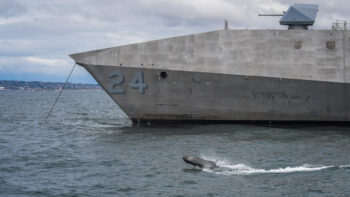
WASHINGTON: Iran’s growing military arsenal is about to get a little bigger in the coming months, the country’s defense chief said this week.
A new Iranian-built spy plane and satellite are slated to go operational next month, Defense Minister Brig. Gen. Ahmad Vahidi told the official Iranian news agency IRNA yesterday. The new “maritime patrol aircraft” will be outfitted with upgradable optical and radar surveillance systems to keep tabs on the country’s coastlines, according to news reports. Vahidi did not comment on the aircraft itself, except to say the spy plane was designed and manufactured by Iranian engineers. Tehran claims to have gleaned reams of information on U.S. aerial surveillance systems from the top secret RQ-170 drone captured by Iranian forces in December. But it’s unlikely that Iranian engineers can incorporate any of that technology into its new surveillance aircraft. It will likely take months, or even years, before Iran can take anything its learned from the so-called “Beast of Kandahar” and work it into a functioning weapons system.
The new satellite, dubbed “Fajr” which means Dawn in Farsi, will be the first of three different satellites Iran plans to launch over the next few years. Vahidi did not say when the next two satellites, named “Navid” and “Tolou”, would be launched. The 110-pound Navid-class satellite is rumored to be able to take low-resolution images of specific targets from upwards of 200 miles above the earth. Iran’s first satellite entered orbit in 2009, making it only the ninth country to have such a capability, according to Iranian media.
Tehran plans to unveil the new systems on February 1st, to commemorate the 34-year anniversary of the 1978 Iranian Revolution, Vahidi said. Their scheduled arrival also comes when tensions between Iran and the United States are at an all-time high.
Earlier this month, Iran infuriated Western leaders by threatening to shut down the Straits of Hormuz, the main waterway entering into the Persian Gulf. Weeks of diplomatic saber-rattling between Tehran and Washington forced Iran to back off, but not before it banned U.S. Navy warships from entering the Straits. But the Pentagon’s announcement last week that two carrier strike groups were headed to the region put forces on both sides back on high alert. Iran has also begun a new round of naval exercises focused on defending the Straits from an attack, according to reports from Tehran.
However, Vahidi reiterated these new systems would be used for peaceful means. The new satellites are intended to help Tehran’s space program “probe the cosmos and unravel the mysteries of the universe,” he said. The new spy plane, he added, would only fly missions to protect Iran’s shores from potential threats. The addition of these new intelligence systems is only the latest effort by Iran to strengthen their military forces. In November, Iranian military leaders rolled out a new class of mini-submarines. Those subs are a small part of a larger effort to expand Iran’s naval forces. That expanded force could be able to control regional waterways spanning from the Indian Ocean to the Straits of Malacca.
‘The bad day’: DISA’s forthcoming strategy prepares for wartime coms
“It’s great to have internet day to day in peacetime,” said Lt. Gen. Robert Skinner, director of the Defense Information Systems Agency, “but it’s more imperative to have it when bullets are flying.”


























